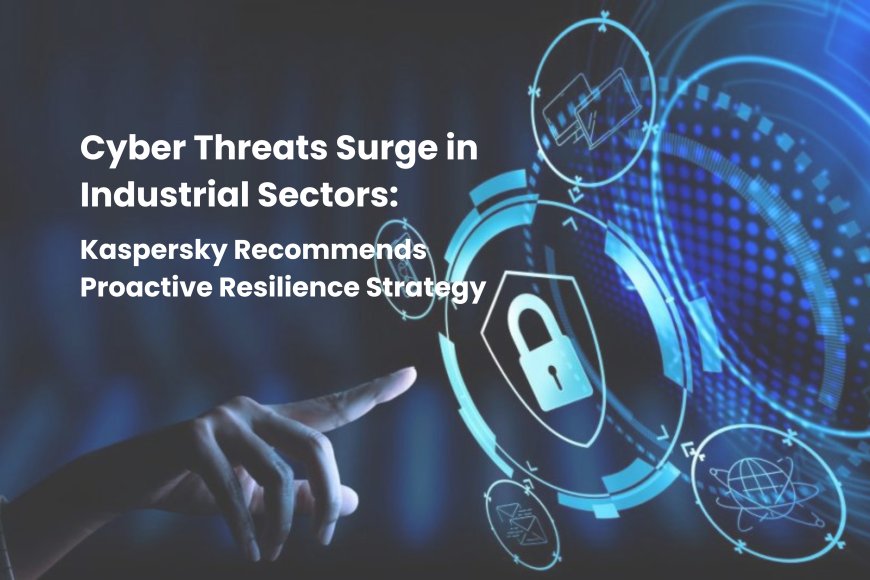Industrial Enterprises at Risk: How Kaspersky’s Eight Cybersecurity Steps Can Strengthen Defenses
Industrial sectors face growing cyber threats; Kaspersky outlines eight key steps to boost resilience, ensure continuity, and protect critical infrastructure from evolving attacks.

Cyberattacks are becoming more common, and industrial sectors are being targeted more often. According to Kaspersky, these sectors accounted for a significant 25.7% of cyber incidents in 2024 alone. Unfortunately, many organizations are still not adequately prepared to defend themselves.
A recent report from the World Economic Forum showed that only 19% of cybersecurity leaders feel sure their company can handle cyber threats. The consequences of a successful cyberattack can be severe — from production downtime and data breaches to safety hazards and financial losses.
Cyber resilience is more than just IT security; it's about keeping operations running, protecting sensitive data, and staying compliant with regulations. A cyberattack on an industrial system can bring entire operations to a halt, leading to massive financial setbacks and even physical risks like power outages or environmental accidents.
Resilient companies, on the other hand, are better prepared to bounce back quickly. They’re also more likely to protect their data, avoid legal penalties, and maintain customer trust. Industrial control systems, which run critical infrastructure, are especially vulnerable. With the growth of connected devices and digital tools, protecting these systems is more urgent than ever.
A cyber breach doesn’t just hurt your reputation — it hits your wallet. From recovery costs to regulatory fines and lost revenue, the financial impact can be huge. That’s why cyber resilience is also a smart business decision. Strong security practices may even lead to lower insurance premiums and higher operational efficiency.
8-Step Cybersecurity Strategy
Inventory: The first step in building cyber resilience is knowing exactly what you have. This means creating a complete list of all your digital and physical assets — like computers, servers, software, network devices, control systems, and even communication paths. Think of it as taking stock before securing a house; if you don’t know what’s inside, how will you protect it? Every asset in your infrastructure should be tracked and monitored. Without this visibility, some devices may go unprotected, becoming easy targets for hackers.
Assess: Once you know what’s in your system, it’s time to figure out how vulnerable it is. A risk assessment helps you understand where your weak points are. You look at things like what kind of cyber threats could target your organization, how badly those threats could impact you, and what protective measures you already have. This process helps you focus your cybersecurity efforts on the areas that need the most attention and avoid wasting resources on low-risk areas.
Secure:This step is all about putting in place the basic protections that every organization needs. This includes things like antivirus software, firewalls, and endpoint protection (security software on each computer or device). These tools act as your first line of defense — they stop common threats, detect malicious activity, and block it before it causes damage. It’s like having locks and alarms in your home — you need them to prevent unwanted intrusions.
Detect: Even with basic protection in place, some threats might still sneak through. That’s why it’s important to install systems that can detect suspicious behavior. These tools constantly monitor your network and systems to spot unusual activities that might indicate a cyberattack. For example, if a machine starts sending out a lot of data unexpectedly, or if someone tries to access sensitive files at odd hours — these are red flags. Early detection gives you a better chance to respond quickly and stop the attack before it spreads.
Audit:Think of this step like a health check for your cybersecurity. Regular audits help ensure that your protective measures are actually working as they should. Auditors look at whether your systems meet industry regulations, check for vulnerabilities, and provide recommendations for improvement. Keeping up with audits not only strengthens your security but also helps you stay compliant with legal standards — which can save you from hefty fines and penalties down the road.
Enhance: Your industrial network can be divided into different zones, based on how important or sensitive the systems are. For example, one zone might handle regular office tasks, while another controls critical machinery. Conduits are the connections between these zones. By carefully organizing and securing these zones and conduits, you can limit how far a cyberattack can spread if it does happen. This way, even if one area is compromised, the rest of your system stays safe.
Monitor: To respond effectively to cyber threats, companies need a Security Operations Center (SOC). A SOC is a team of cybersecurity experts that monitors your network 24/7. They analyze threats, respond to incidents, and improve security based on real-time intelligence. As threats get more complex, your SOC should evolve with better tools, smarter detection, and faster response capabilities. A strong SOC is like having a security team guarding your digital environment day and night.
Prepare: Being prepared means assuming that attacks will happen — and planning for it. Organizations should simulate cyberattacks and test how well their systems and teams can handle them. These exercises help identify weak spots in your defense and train employees on how to respond. Fault tolerance ensures that your systems can keep running even during an attack. Also, don’t forget people — employees must be regularly trained on cybersecurity practices, as human error is often the weakest link.
In today’s digital world, cyber resilience isn’t optional — it’s essential. It isn’t a one-time fix — it’s an ongoing effort. s threats evolve, so should your defenses. By implementing these steps, industries can protect their operations, ensure compliance, and stay ahead of cybercriminals.
Information referenced in this article is from The Economic Times







